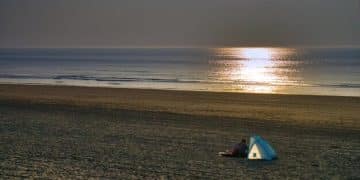Beach Scavenger Hunt Ideas: Fun Activities for All Ages

Engaging in a beach scavenger hunt offers a delightful and educational activity for individuals and families alike, transforming a simple day by the sea into an exciting adventure of discovery and exploration, blending fun with the natural beauty of coastal environments.
Transforming a trip to the beach into an exciting quest for discovery can elevate a simple outing into a memorable adventure. A well-planned beach scavenger hunt ideas: fun activities for kids and adults not only entertains but also encourages observation and interaction with the unique coastal environment.
The Appeal of Beach Scavenger Hunts
Beach scavenger hunts offer a unique blend of fun, education, and physical activity, making them an ideal pursuit for families, friends, or even solo adventurers. The natural landscape of a beach provides an ever-changing canvas for discovery, ensuring that no two hunts are exactly alike. These engaging activities can range from simple lists for younger children to more complex, themed quests designed to challenge adults, fostering teamwork and keen observation skills.
The beauty of a beach scavenger hunt lies in its adaptability. You can tailor the difficulty and the items to be found based on the age group, the specific beach environment, and even the weather conditions. Beyond entertainment, these hunts subtly promote an appreciation for marine life and coastal ecosystems, encouraging participants to look closely at the sand, shells, and water, uncovering the hidden wonders that often go unnoticed during a casual stroll.
Why Beach Hunts are So Engaging
A beach hunt taps into our innate curiosity and provides a structured way to explore. It transforms passive beach-going into an active, immersive experience. The thrill of finding a rare shell or a uniquely shaped pebble adds an element of surprise and reward, reinforcing positive engagement with nature.
- Develops observation skills.
- Encourages critical thinking.
- Promotes physical activity and fresh air.
- Fosters teamwork and communication.
For children, the hunt can be a fantastic way to burn off energy while learning about the natural world in a hands-on manner. For adults, it can be a relaxing yet stimulating activity, a welcome break from daily routines, and an opportunity to connect with nature and fellow participants on a different level. It’s a chance to slow down, notice the small details, and appreciate the intricate beauty of the beach environment.
Ultimately, a beach scavenger hunt is more than just a game; it’s an opportunity to create lasting memories, deepen connections with loved ones, and foster a greater understanding and respect for our natural surroundings.
Planning Your Perfect Beach Hunt
Executing a successful beach scavenger hunt requires a touch of thoughtful planning. From choosing the right location to preparing your list of items, each step contributes to an enjoyable and memorable experience. Consideration of the participants’ ages and interests is paramount, as this will dictate the complexity and theme of your hunt. A well-prepared hunt ensures that everyone, from the youngest explorer to the most seasoned beachcomber, finds joy in the discovery.
Starting with the basics, define your objectives. Are you aiming for educational fun, competitive excitement, or a relaxed exploratory activity? This will guide your choices for the scavenger list and any additional rules or materials. Remember, the goal is to enhance the beach experience, so flexibility and a sense of adventure are key to overcoming any unexpected challenges, like shifting tides or sudden weather changes.
Selecting the Ideal Beach Location
Not all beaches are created equal for scavenger hunts. Consider beaches known for their diverse shell populations, interesting rock formations, or even driftwood. Avoid overly crowded areas if you’re looking for unique finds, as popular spots tend to be picked over quickly. Researching the typical finds for a specific beach can also help in crafting a realistic and exciting list.
- Look for beaches with varied natural elements.
- Check tide schedules for optimal finding conditions.
- Consider accessibility and parking.
- Assess safety, especially for younger participants.
A beach with a mix of sandy stretches and rocky outcrops can offer a wider variety of items to discover, creating a more dynamic hunting ground. Always prioritize safety, especially when exploring areas near water or uneven terrain. Inform participants about potential hazards, such as sharp shells or slippery rocks, and emphasize responsible behavior.
Crafting Your Scavenger List

The scavenger list is the heart of your hunt. It should be challenging but achievable, with items that encourage observation rather than just quick finds. For younger children, include common items like specific shell types (e.g., spiral shell, clam shell), a smooth pebble, or a feather. For adults, you might include more abstract items or require participants to interpret clues rather than just find objects.
Consider adding a creative twist, such as finding something that looks like a specific letter of the alphabet, or an item that represents a certain emotion. This encourages participants to think outside the box and interact with their surroundings in a unique way. Providing visual aids, like pictures of the items, can be particularly helpful for non-readers or very young children.
Before finalizing your list, do a quick scout of the beach yourself to ensure the items are genuinely present and reasonably discoverable. This pre-hunt reconnaissance helps prevent frustration and ensures a rewarding experience for everyone involved.
Scavenger Hunt Ideas for Kids
Engaging younger participants in a beach scavenger hunt requires creativity and an understanding of their developmental stage. The focus should be on simplicity, visual recognition, and the sheer joy of discovery, rather than complex challenges. A well-designed hunt for kids can turn a typical beach day into an exciting educational expedition, fostering curiosity about the natural world around them.
The best hunts for children combine familiar objects with a few novel finds, ensuring a balance between easy successes and delightful surprises. Keep the lists short and the items clearly identifiable. Think in terms of shapes, colors, and common attributes that even the youngest explorers can grasp, making the activity accessible and fun for all.
Simple “Find and Collect” Lists
For toddlers and preschoolers, a “find and collect” list focusing on basic characteristics is perfect. This can be a visual list with pictures of items rather than words. The goal is to encourage observation and fine motor skills as they pick up items.
- A smooth, round stone.
- A white shell.
- A piece of green seaweed.
- A feather.
- A shiny object.
Keeping the list short, perhaps 5-7 items, prevents overwhelming young children. Celebrate every find, no matter how small, to build their confidence and enthusiasm. Make it about the process of looking and discovering, not just about completing the list.
Sensory Beach Exploration
Introduce a sensory element to the hunt. Instead of just finding items, challenge children to find things based on how they feel or sound. This adds another layer of engagement and encourages different types of observation.
- Something rough.
- Something smooth.
- Something that makes a tinkling sound (like shells hitting each other).
- Something that smells like the ocean.
- Something soft.
This type of hunt fosters a deeper connection with the environment, sharpening their senses and expanding their understanding of textures and sounds in nature. It prompts them to use more than just their eyes, making the experience richer and more memorable.
Color-Themed Hunts
A color-themed hunt is visually appealing and easy for kids to understand. Provide a list of colors and ask them to find an object for each color. This can be a great way to reinforce color recognition for younger children.
For instance, they might search for something blue (a piece of plastic, a unique pebble), something brown (driftwood, a specific type of shell), or something grey (a rock, a certain type of sand). This variation keeps the hunt fresh and encourages them to look for variety within their finds.
Remember to emphasize that collecting live creatures or disrupting marine habitats is off-limits. Teach them to observe and appreciate without disturbing the natural balance of the beach.
Advanced Scavenger Hunt Ideas for Adults
While the essence of a scavenger hunt remains constant—the thrill of discovery—the complexity and aims for adult participants can be significantly elevated. Moving beyond simple item collection, adult-focused hunts integrate elements of puzzle-solving, photography, and even creative interpretation, transforming a casual stroll into a more intellectually stimulating and collaborative experience. These hunts are designed to challenge observational skills, encourage creative thinking, and foster deeper engagement with the coastal environment.
The ultimate goal for adult hunts is to provide a fresh perspective on familiar surroundings, pushing participants to notice details they might otherwise overlook. Whether it’s a competitive race or a leisurely artistic pursuit, an advanced beach scavenger hunt offers a satisfying blend of adventure and mental exercise, making it perfect for group gatherings or team-building activities.
Photography Challenges
Instead of collecting physical items, challenge adults to capture specific photographs. This encourages creative composition and keen observation, as they look for angles and light that highlight the requested subjects.
- A reflection in a tide pool.
- The oldest-looking piece of driftwood.
- A bird in flight.
- A unique shell pattern.
- The intersection of sand and water.
Adding a time limit or a theme, such as “patterns of the beach” or “beach life,” can further enhance the challenge. Participants can then share their photos, leading to discussions and appreciation of different perspectives. This approach leaves the beach undisturbed while still providing a rewarding activity.
Riddle and Clue Hunts
Create a series of riddles or clues that lead participants from one location or item to the next. Each successful find provides the next clue, building suspense and requiring deductive reasoning. This mimics a treasure hunt and can be quite engaging.
For example, a clue might lead them to “the place where the sea whispers secrets inside a spiral chamber,” directing them to find a specific type of conch shell. Or a riddle could describe a landmark, guiding them to its location to find the next hint. This requires more preparation but offers a highly rewarding and dynamic experience.
Themed Story Hunts
Develop a narrative or a historical theme around the hunt. Participants are tasked with finding items that relate to the story, piece by piece. This could involve local folklore, pirate legends, or even a fictional tale you’ve created.
For example, a “Message in a Bottle” hunt where fragments of a story are found inside various containers disguised around the beach. Or a “Geological Journey” where clues lead to different types of rocks, each revealing a part of the Earth’s history relevant to that specific coastline. This adds a rich layer of immersion and educational value to the activity.
Consider incorporating elements that encourage mindfulness, like finding “something that shows resilience” (a plant growing in sand) or “something that represents tranquility” (a perfectly smooth, weathered stone). Such abstract concepts push participants to think metaphorically and connect with the environment on a deeper level.
Safety and Ethical Considerations
While the excitement of a beach scavenger hunt is undeniable, prioritizing safety and ethical conduct is paramount. The beach environment, with its dynamic tides, diverse marine life, and varying terrain, demands respect and caution. A responsible approach ensures that participants remain safe, and the delicate coastal ecosystem remains undisturbed. Education on proper beach etiquette and environmental awareness should be an integral part of planning any hunt.
Before commencing any activity, a clear briefing on potential hazards and essential guidelines is crucial. Emphasize observation over collection, especially concerning living organisms, and encourage a “leave no trace” philosophy. By adhering to these principles, a beach scavenger hunt can be a truly enriching experience that benefits both participants and the environment.
Environmental Responsibility: Leave No Trace
The most important ethical consideration is to “leave no trace.” Encourage participants to observe and photograph rather than collect. If collecting is part of the hunt, specify only dead, common items like shells or pebbles, and limit the quantity.
- Do not disturb or collect living organisms (shells with creatures inside, crabs, starfish).
- Do not remove plants or disrupt plant life.
- Do not leave any trash behind; bring out everything you brought in.
- Avoid walking on sand dunes or protected areas.
Educate participants about the fragility of marine ecosystems and the importance of preserving them for future generations. Emphasize that the fun of the hunt should not come at the expense of the natural habitat.
Tide Awareness and Dangers
Understanding tide patterns is critical for beach safety. High tides can cut off access to certain areas, and rapid incoming tides can create dangerous situations. Always check the local tide charts before planning your hunt.
Warn participants about rogue waves and strong undertows, especially if the hunt involves exploring near the water’s edge or rocky areas. Supervise children closely, and ensure all participants are aware of safe zones and emergency procedures. Never turn your back on the ocean, and be mindful of slippery surfaces on rocks.
Sun Protection and Hydration
Spending hours on the beach can lead to sunburn and dehydration. Remind all participants to apply high-SPF sunscreen, wear hats and sunglasses, and reapply sunscreen regularly. Provide access to plenty of water and encourage frequent hydration breaks.
Even on cloudy days, UV rays can be strong. Encourage light, protective clothing. Taking regular breaks in the shade, if available, can also prevent overheating and exhaustion, ensuring a comfortable and enjoyable experience for everyone involved.
By integrating safety briefings and environmental education, a beach scavenger hunt transforms from a mere game into a responsible and memorable outdoor activity, fostering a deeper respect for nature.
Enhancing the Scavenger Hunt Experience
To truly elevate a beach scavenger hunt from a simple activity to an unforgettable adventure, consider adding elements that engage different senses, foster creativity, and inject friendly competition or collaboration. The details, no matter how small, can significantly enhance participant enjoyment and create lasting memories. It’s about more than just finding items; it’s about the journey, the shared laughter, and the unique discoveries made along the way.
Beyond the core list, incorporating rewards, creative prompts, or even a thematic backdrop can transform the hunt into a more immersive and interactive event. The goal is to maximize engagement, ensuring everyone, regardless of age or competitive spirit, feels included and excited by the chase. Remember, flexibility in rules and an open mind to spontaneous discoveries can often lead to the most unexpected and cherished moments.
Incorporating Creative Challenges
Beyond finding items, add challenges that require creativity or problem-solving. This could involve building a small sand sculpture using found objects, or arranging collected items into a piece of “beach art.”
- Build a unique sandcastle using found shells and pebbles.
- Create a “found object” collage from natural beach items.
- Compose a short poem inspired by a collected item.
- Act out a short skit using items found on the beach.
These creative extensions add another dimension to the hunt, encouraging artistic expression and a deeper connection with the environment. It shifts the focus from merely collecting to creating, providing a more multifaceted experience.
Reward and Recognition
While the joy of discovery is its own reward, a small token of recognition can add to the excitement, especially for children. This doesn’t have to be monetary; it could be a special “Beach Explorer” certificate, a shared ice cream, or bragging rights.
For competitive hunts, consider funny awards like “Most Creative Find” or “Best Team Effort” rather than just “Most Items Found.” This ensures that participants focus on the spirit of the hunt and camaraderie rather than just winning. Celebrate everyone’s unique contributions, fostering a positive and inclusive atmosphere.
Themed Beach Scavenger Hunts
Give your hunt a specific theme to add an immersive layer. This could be anything from a “Pirate Treasure Hunt” where clues lead to a hidden “treasure chest” (filled with snacks or small toys), to a “Marine Biologist Adventure” seeking out specific types of marine flora and fauna.
A “Color Palette” hunt could challenge participants to find items that match a pre-selected color scheme, encouraging an artistic eye. Tailoring the theme to the interests of the participants can make the experience even more engaging and memorable, creating a sense of a shared journey with a unique purpose.

Always encourage participants to share their finds and experiences. This peer interaction enhances the social aspect of the hunt, allowing everyone to learn from each other’s discoveries and perspectives.
Creating Lasting Beach Memories
A beach scavenger hunt is far more than a transient activity; it’s an opportunity to forge indelible memories and strengthen bonds among participants. The shared laughter, the thrill of discovery, and the collective engagement with nature combine to create an experience that resonates long after the sand has been shaken from shoes. The uniqueness of each beach, coupled with the varied items one can discover, ensures that every hunt yields its own distinct set of cherished moments.
From the simplest finds to the most challenging clues, the scavenger hunt actively engages the senses and the mind, making every moment an active part of the memory-making process. These experiences contribute to a deeper appreciation for the natural world and the people with whom they are shared, transforming a regular beach day into a story worth retelling.
Documenting Your Discoveries
Encourage participants to document their finds, either through photography, sketching, or by creating a “treasure map” of their journey. For collected items, creating a “display” or a “memory box” later can serve as a physical reminder of the day’s adventures.
- Take photos of unusual finds or interesting beachscapes.
- Journal about the experience, noting funny moments or surprising discoveries.
- Create a digital photo album or social media post to share the fun.
- Use collected items to make a craft or collage once home.
Documenting the hunt helps to solidify the memories and provides tangible keepsakes of the experience. It also allows participants to reflect on their adventure and share their excitement with others, extending the enjoyment beyond the beach itself.
Fostering Connection and Teamwork
Beach scavenger hunts are inherently communal activities, fostering communication and teamwork. Whether working together to find an elusive item or sharing theories on where the next clue might be, participants engage in cooperative play that strengthens their relationships.
The shared goal of the hunt naturally encourages participants to combine their unique observational skills and problem-solving abilities. This collaborative spirit often leads to unexpected insights and a deeper appreciation for each other’s capabilities, reinforcing the idea that teamwork makes the dream work—especially on a beach full of hidden treasures.
Reflecting on the Experience
After the hunt, take time to reflect on the experience. Discuss what everyone found, what was challenging, and what their favorite parts were. This debriefing allows for shared storytelling and reinforces the positive aspects of the activity.
Ask open-ended questions like, “What surprised you the most about the beach today?” or “What’s an item you wish you had found?” Such reflections deepen the learning and emotional connection to the experience, making the memories more potent and lasting for everyone involved.
Ultimately, a beach scavenger hunt is a versatile and enriching activity that offers endless possibilities for fun, learning, and connection. By embracing creativity, prioritizing safety, and fostering a spirit of exploration, you can transform any beach outing into an unforgettable adventure, creating memories that will be cherished for years to come.
| Key Point | Brief Description |
|---|---|
| 🐚 Diverse Fun | Scavenger hunts cater to all ages, from simple “find-and-collect” for kids to complex riddle-based quests for adults. |
| 📝 Planning is Key | Successful hunts require careful planning: choosing the right beach and crafting age-appropriate, engaging lists. |
| ⚠️ Safety First | Prioritize safety and environmental responsibility; avoid disturbing marine life and practice “leave no trace.” |
| 📸 Enhance Experience | Add photography challenges, creative tasks, and small rewards to make the hunt more memorable and interactive. |
Frequently Asked Questions
▼
Beach scavenger hunts are incredibly versatile and can be adapted for virtually any age group. For young children, simple visual lists focusing on colors or common objects work well. For teens and adults, the hunt can incorporate more complex riddles, photography challenges, or themed narratives, making it equally engaging and stimulating.
▼
The best items depend on the beach’s characteristics and participants’ ages. Common finds include various types of shells (spiral, clam, broken), sea glass, unique pebbles, driftwood, feathers, or a specific type of seaweed. For advanced hunts, consider items representing abstract concepts like “something smooth” or “something old.”
▼
To make it educational, include items that teach about marine biology or geology. For example, ask participants to identify specific types of shells or rocks, or to find evidence of different marine life. Incorporating facts about the items or the ecosystem during the hunt can also enhance learning.
▼
Always check tide charts to avoid getting stranded by rising waters. Advise participants to wear sunscreen, hats, and protective clothing, and to stay hydrated. Emphasize not to disturb live marine creatures or shells potentially harboring them. Supervise children closely, especially near the water.
▼
Absolutely! A non-collecting scavenger hunt is an excellent way to practice “leave no trace” principles. You can create lists that require participants to photograph items, draw them, or describe their characteristics. This encourages keen observation and appreciation for the environment without removing anything from it.
Conclusion
Ultimately, a beach scavenger hunt offers a delightful and versatile approach to enjoying coastal environments, equally engaging for both children and adults. By blending careful planning with spontaneous discovery, these activities transcend simple recreation, fostering observation, critical thinking, and a deeper appreciation for nature’s nuances. Prioritizing safety and environmental stewardship ensures that the joy of discovery harmonizes with a responsible interaction with the delicate beach ecosystem. Whether a quest for specific shells or a photographic exploration of coastal patterns, a well-curated scavenger hunt transforms a day at the beach into an enriching and memorable adventure for everyone involved.





